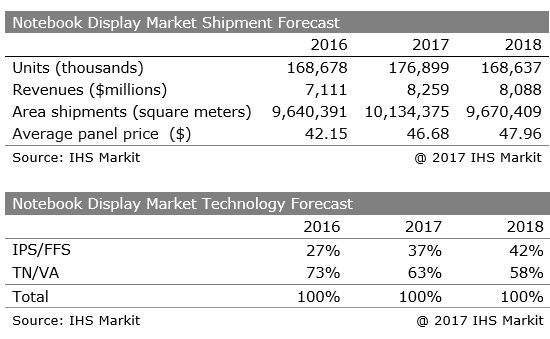[테크월드=이나리 기자] Display shipments for notebook PCs are forecast to increase by 5 percent in 2017 to 177 million units compared to the previous year, while notebook PC unit shipments are expected to remain flat during the same period. Being worried about slower shipments next year due to higher inventory, panel makers are focusing on expanding high-end displays, such as in-plane switching (IPS) technology and low-power consuming displays.
According to IHS Markit, analytics and solutions, IPS displays with wide-view angle and high color accuracy are expected to make up 37 percent of total notebook PC panel shipments in 2017, up from 27 percent in 2016. The share will continue to grow in 2018 to 42 percent.
“Production of IPS panels could bring economic benefits to panel makers, such as higher price and larger capacity consumption,” said Jason Hsu, senior principal analyst at IHS Markit.

The price of a typical IPS panel is about 30 percent higher than a conventional twisted nematic (TN) panel of the same size, while a premium IPS panel can cost double or higher. Moreover, producing one IPS panel will consume capacity more than 20 percent compared to producing a TN panel since it requires more photo masks, resulting in a longer take-time in the production line.
Lenovo, the largest IPS panel buyer, is estimated to purchase more than 12 million units of IPS panels in 2017. Dell has been focusing on the mid- and hi-end segments, applying more IPS panels to its products than its competitors. HP is also expanding IPS panel adoption, contributing to the IPS panel shipment growth in 2018.
Another feature display makers are focusing on is displays that consume lower power. As slim notebook PCs become the design trend, low-power consumption display is a critical need as the battery capacity is limited due to very compact chassis. With the advanced substrate technology such as oxide and low-temperature polycrystalline silicon (LTPS), the power consumption of LCD panel can be managed at a lower level.
According to IHS Markit, adoption of oxide and LTPS panels in the notebook PC market is expected to grow from 3 percent in 2016 to 10 percent in 2017 and to 13 percent in 2018. In the past, these advanced panel technologies were mostly used for premium panels like ultra-high definition (UHD)/wide quad HD (WQHD) resolution displays, but the application will expand to full HD resolution displays, driving the market demand.
In 2018, panel suppliers may have more pressure to maintain panel prices as panel oversupply is expected to continue. “But if the display evolution continues, raising the average selling price, panel makers will not necessarily struggle,” Hsu said.
The average selling price of a notebook PC panel is expected to increase to $46.68 in 2017 and to $47.96 in 2018, from $42.15 in 2016. “Although shipments in unit might decline next year, there are still opportunities for panel makers to increase revenues.”
그래도 삭제하시겠습니까?



